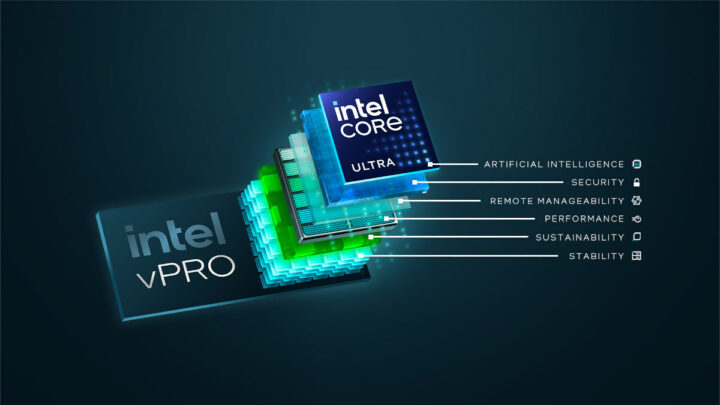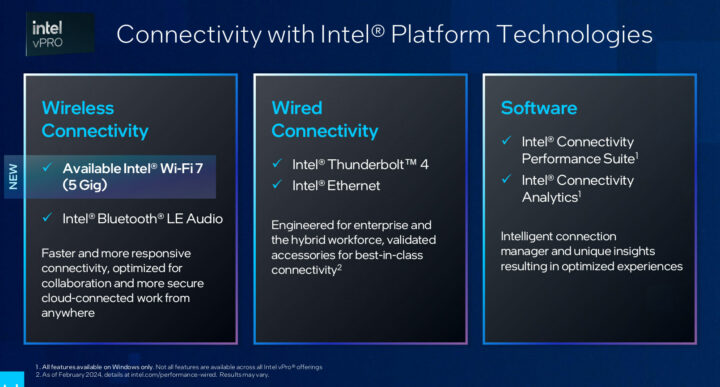Intel Core Ultra 5 134U and Core Ultra 7 164U are new 12-core Meteor Lake processors with 9W PBP (Processor Base Power) and 30W Max Turbo Power (MTP) that appear to have recently been added to Intel Ark.
Intel just announced Intel vPro Platform support for the Core Ultra Meteor Lake processors to make those more suitable to business customers with improved security through AI-powered Intel Threat Detection Technology, better manageability with the Intel Device Discovery comprised of cloud-based tools for managing PCs remotely, and enhanced stability thanks to Intel’s Stable IT Program aiming to validate and ensure Windows 10 and Windows 11 compatibility.
But Liliputing also notes that Intel has added some 9W parts besides the existing 15W parts such as the Intel Core Ultra 5 125U or Core Ultra 7 165U, namely the Core Ultra 5 134U and Core Ultra 7 164U. They are quite similar to the other 15W Meteor Lake-U parts with 12 cores in 2 P-Core+8 E-Core+2 LP-Core configuration, 14 threads, 12MB cache, and Intel UHD graphics with 4 Intel Xe GPU cores, but there are some differences as shown in the table below.
Core Ultra 5 134U | Core Ultra 7 164U | Core Ultra 5 125U | Core Ultra 5 135U | Core Ultra 7 155U | Core Ultra 7 165U |
|
|---|---|---|---|---|---|---|
| PBP/MTP | 9W/30W | 15W/57W |
||||
| Base frequency (P/E/LP) | 700 MHz / 500 MHz / 400 MHz | 1.1 GHz / 700 MHz / 400 MHz | 1.3 GHz / 800 MHz / 700 MHz | 1.6 GHz / 1.1 GHz / 700 MHz | 1.7 GHz / 1.2 GHz / 700 MHz | 1.7 GHz / 1.2 GHz / 700 MHz |
| Max Turbo Freq. (P/E/LP) | 4.4 GHz / 3.6 GHz / 2.1 GHz | 4.8 GHz / 3.8 GHz / 2.1 GHz | 4.3 GHz / 3.6 GHz / 2.1 GHz | 4.4 GHz / 3.6 GHz / 2.1 GHz | 4.8 GHz / 3.8 GHz / 2.1 GHz | 4.9 GHz / 3.8 GHz / 2.1 GHz |
| Max GPU frequency | 1.75 GHz | 1.80 GHz | 1.85 GHz | 1.9 GHz | 1.95 GHz | 2.00 GHz |
| RAM | 64GB Up to LPDDR5/x 6400 MT/s | 96GB Up to LPDDR5/x 7467 MT/s, up to DDR5 5600 MT/s |
||||
| PCIe | 12-lane PCIe 4.0 and 3.0 1 (x4) Gen4 + 4 (x1,x2,x4) Gen4 + 4 (x1,x2,x4) Gen3 | 20-lane PCIe 4.0 3 (x4) Gen4 + 8 (x1,x2,x4) Gen4 |
||||
| Package | FCBGA2551 (23 x 19 mm) | FCBGA2049 (50 x 25 mm) |
||||
The new 9W Meteor Lake U-series Type4 processors come in a smaller package, offer fewer PCIe 4.0/3.0 lanes, and support (only) up to 64GB LPDDR5 RAM, while the 15W SKUs can handle up to 96GB. They’ll likely be found in thinner laptops and mini PCs be it actively cooled or fanless. Other notable features include Intel AI Boost NPU for AI acceleration, Thunderbolt 4 interfaces, and support for WiFi 7 and Bluetooth LE audio which are common to all Meteor Lake processors.

Jean-Luc started CNX Software in 2010 as a part-time endeavor, before quitting his job as a software engineering manager, and starting to write daily news, and reviews full time later in 2011.
Support CNX Software! Donate via cryptocurrencies, become a Patron on Patreon, or purchase goods on Amazon or Aliexpress






